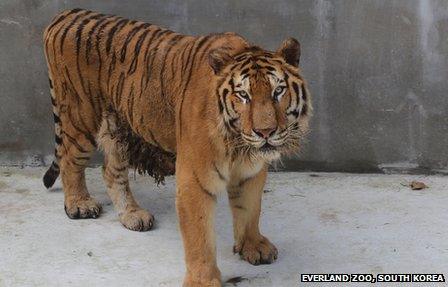Genomes of big cats revealed
- Published

International scientists have mapped the genomes of the tiger, lion and snow leopard, in conservation efforts to protect endangered species.
The research give clues to how big cats evolved to become top predators with superior muscle strength and a carnivorous diet.
The tiger shares 96% of its genes with the house cat, the study in Nature Communications reveals.
Until now, the only cat to have its DNA mapped was the domestic one.
A team led by Yun Sung Cho at the Personal Genomics Institute, Genome Research Foundation in Suwon, South Korea, sequenced the genome of a Siberian tiger.
The individual, Taegeuk, is a nine-year-old male from Everland Zoo in South Korea.
The team then sequenced the DNA of four other big cats - the (African) lion, snow leopard, white (Bengal) tiger and white (African) lion.
This enabled them to compare how the genes matched up in different members of the cat family.
Genetic signatures show how big cats gained their superior muscle strength, the ability to digest large amounts of meat and a keen sense of smell.
The research also gives genetic clues to how the white lion gained its pale coat and how the snow leopard adapted to the snowy mountain ranges.
One of the lead authors of the report, Jong Bhak, said the tiger genome map will be an important resource for looking at genetic diversity.
The preservation of wild tiger populations, currently estimated at less than 4,000 individuals, is now a major goal of animal conservationists.
"Our tiger reference genome can be used as the basis for comparing all the tigers in the world, so that we know the genetic diversity of tigers," he told the BBC.
"And we can actually have a plan of how we can breed tigers effectively [in zoos] to save the genetic diversity."
He said cats had been very successful in adapting to their environment as predators, which is reflected in the genomes of both the tiger and the domestic cat.
"Tigers are just a big domestic cat," he added. "They're probably much closer than we thought."
Carlos Driscoll is WWF chairman in conservation genetics at the Wildlife Institute of India, Chandrabani.
He said the paper was a watershed in conservation, marking the first non-domestic cat genome to be sequenced.
"This brings the age of genomics to the conservation of these species, which are an umbrella for the conservation of many other animals and habitats," he said.
"This sets a new standard for the conservation community to follow."
The research, published in Nature Communications, was led by scientists in South Korea, in collaboration with colleagues in China, the US, Russia, Namibia, South Africa, The Netherlands, Denmark, Saudi Arabia, India and Mongolia.
- Published1 November 2007
- Published12 June 2013